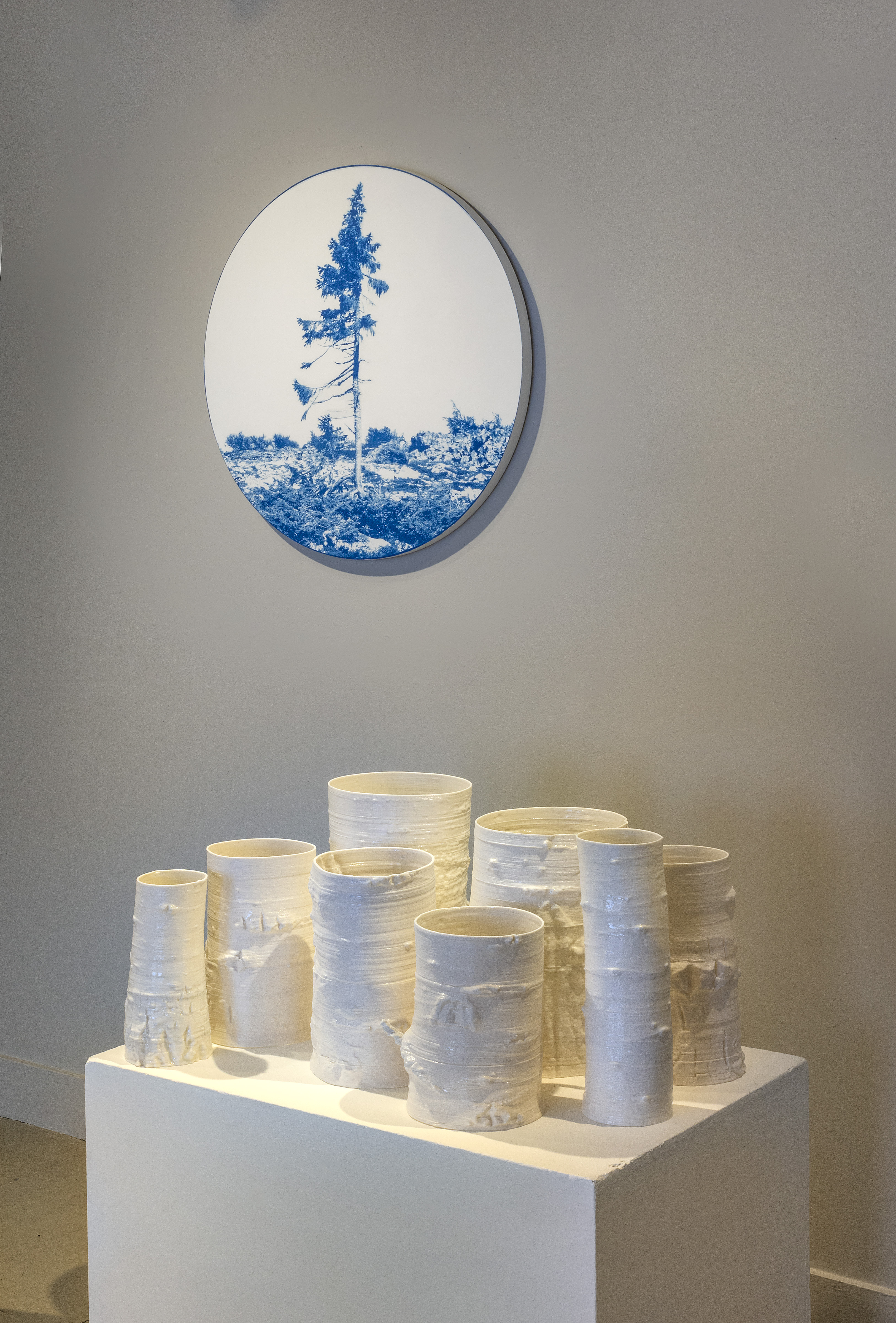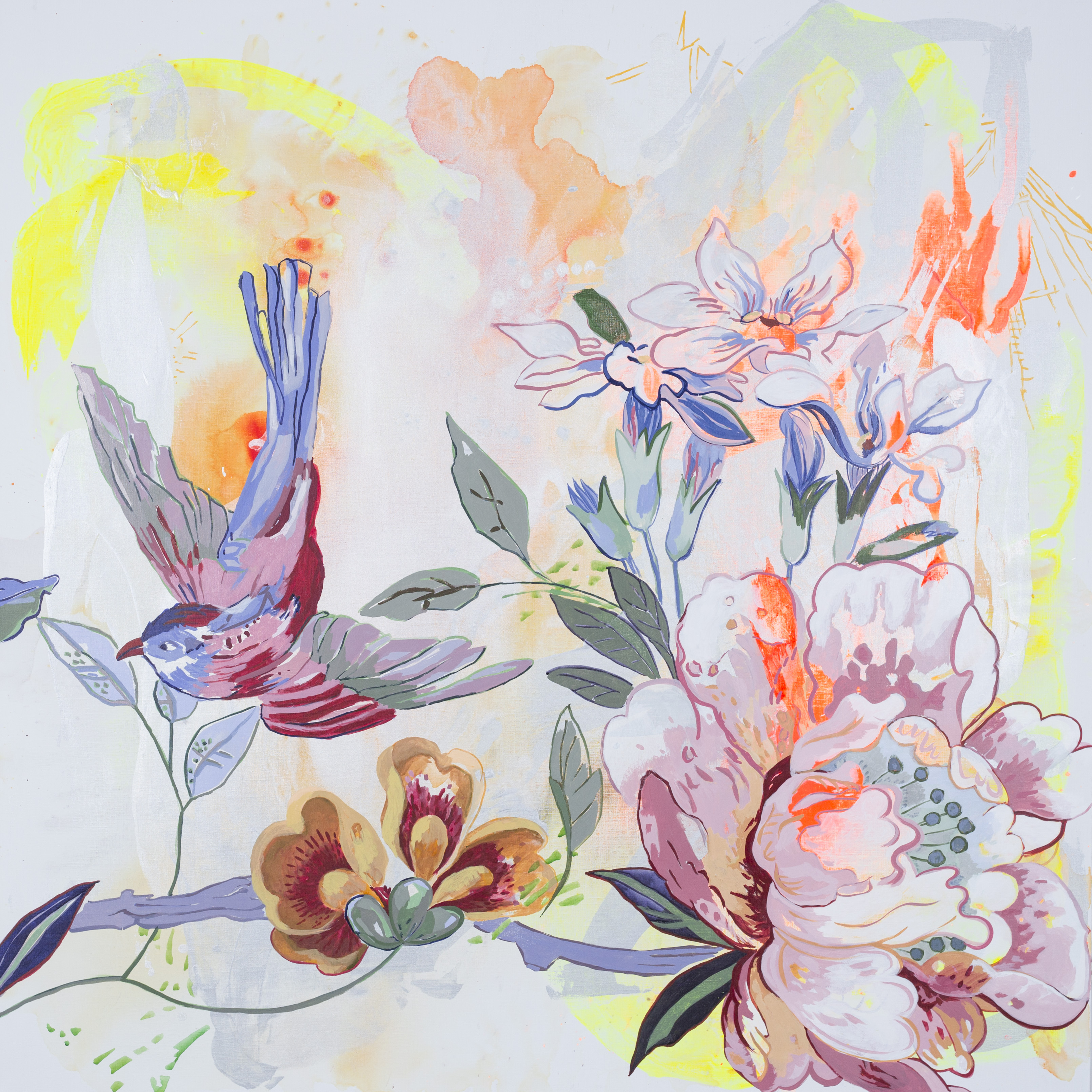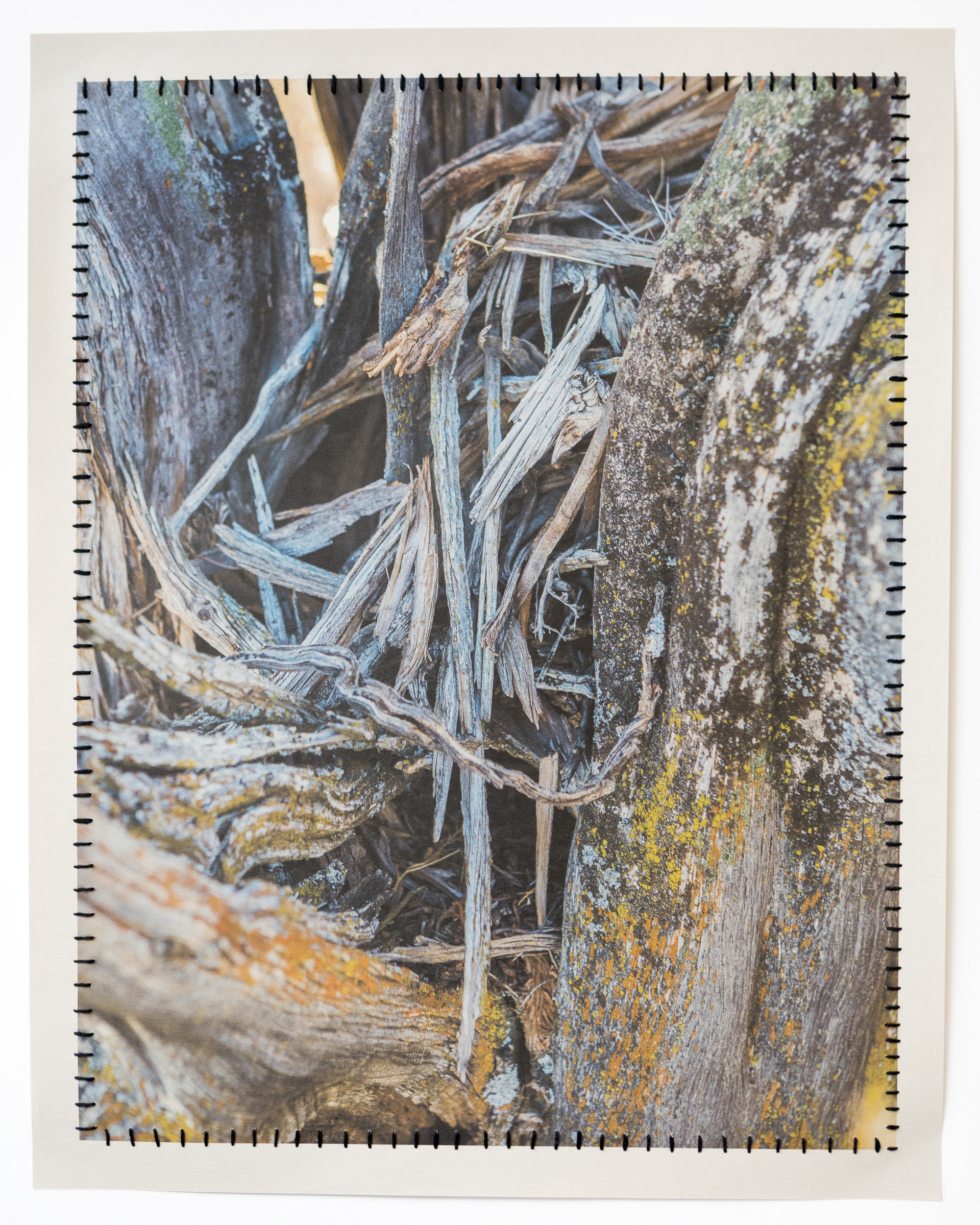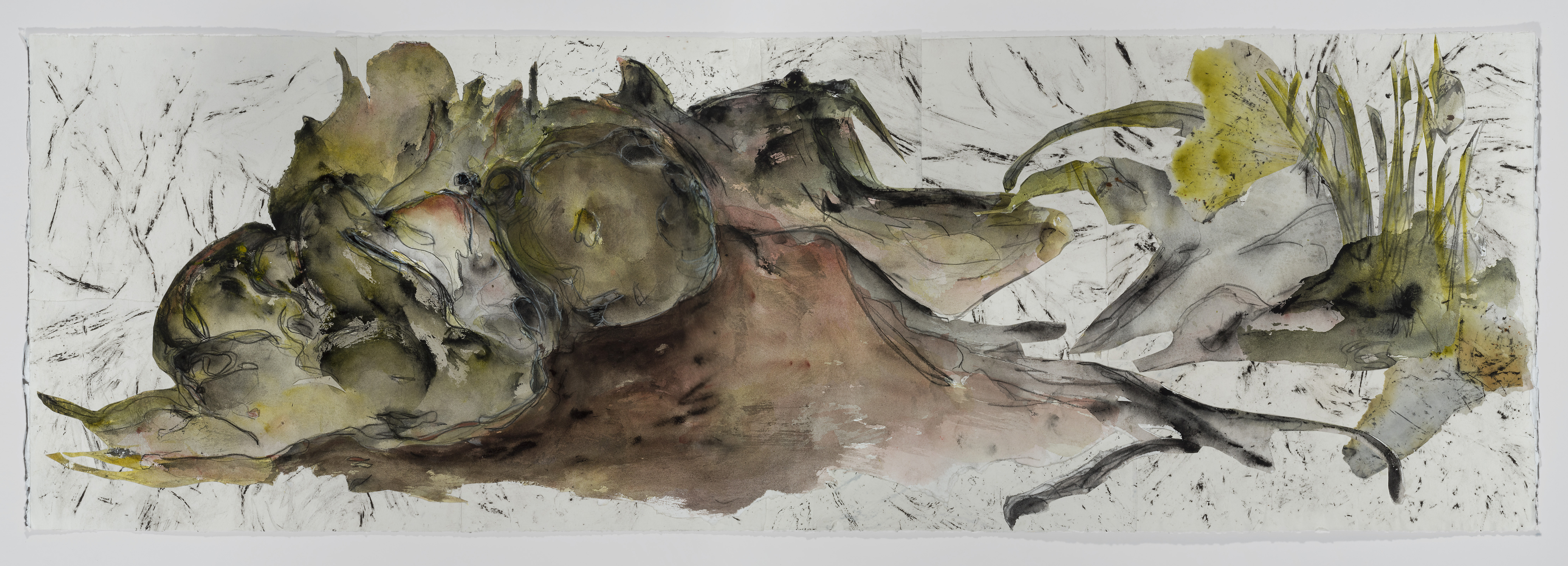
Mia Mulvey, Old Tjikko, 2018, cyanotype on wall and Pando II, 2018, ceramics on pedestal
Slow Steady Movement Towards Change:
Art in a Wild, Isolated Space
Interview with Stefan Hagen from the Montello Foundation and Kate James from Concord Art Association on the recent “This Earth” exhibition including members Mia Mulvey, Elisabeth Condon, Laurie Lambrecht, and Margaret Cogswell.
Olivia Ann Carye Hallstein
On view through May 7, 2023, is an exhibition that surveys artists who have visited the Montello Residency in rural Nevada. This wild and stunning desert landscape allows a unique space for contemplation and reflection. Artists choose to create work on site or use the impressions from their stay to create work in their studios. It is a windowed small cabin on a lonely road in the middle of a vast landscape. I speak with Stefan Hagen and Kate James about their intentions and perspectives on the work being shown, the intentions of the residency and the philosophical basis behind their motivations.

Elisabeth Condon, Urban Jungle, 2016
The Montello residency invites artists from all over the world to witness and reflect on the desert wilderness. What is unique to you about the “artist as a witness” when experiencing these spaces rather than a more quantitatively analytical perspective?
SH: A desert landscape is ideal for observing the fragility of nature. Though it seems that every living entity is adapted to a very harsh environment, but it is also obvious that there is a very precise balance necessary for living things to thriver here. Any footstep will stay visible for at least a month. The extremely slow rate that higher forms of plants grow make it clear that our presence has an irreversible effect, globally and locally. For the residents it is a unique opportunity to spend uninterrupted time in an unusual landscape that becomes familiar to them over the duration of the retreat. It becomes so familiar that they can revisit specific places and experience the interconnectedness of nature. This can be a catalyst for a new direction or influence an existing body of work. The resulting works of art have the ability and the power to influence the audience in a way no quantitative approach can. Since our decisions are largely based on irrational and spontaneous impulses, the work becomes especially influential. The numbers are certainly there to back this up.

Laurie Lambrecht, Desert Driftwood, 2018

Laurie Lambrecht, High Desert Tapestry, 2018
The evidence is clear in a recent show at the Concord Art Association of many of these artists titled “This Earth.” It shows an incredible range of disciplines and topics related to the environment. From photographs to color palettes, to smells, to sculptures with water, and performative works, it is a true survey of perspectives. What have been some of the challenges and surprises you have come across while trying to honor each artist in such a diverse group?
KJ: Yes, this show reflects the diversity of artists who have experienced the residency and offers variable entry points to consider our own relationship to the environment, but the themes remain the same throughout and the variety of experiences. These lead to more chances to connect with the viewer. Some of the work was created at the site and some was inspired while contemplating the desert environment and created post residency. An example of a post-residency production is the video where two artists dress as mussels and sing a pleading song to please protect them. Even a puppet show inspired by a rat living under the Montello cabin speaks to the fragility of life. A theme kept in a conceptual sculptural installation about the water crisis using water from Walden Pond. We literally breathe in Thoreau's conservation ideas by means of water vapor.
Fragility, balance, survival, co-dependence, coupled with awe, wonder and inspiration and the implied or inferred urgency to respect nature all coalesce in the show. The fragility of life in the desert is a paradigm for the fragility of life on earth. The desert setting for this residency makes the artist hyper aware of what threatens our existence. It's poignant that the universal question from viewers who have visited the show has been, "would I be able to be alone and unplugged in the desert." This show subtly honors questions about survival.

Margaret Cogswell, Desert Mounds, 2022, lithograph ink bar rubbing of the desert floor, watercolor, colored pencil and collage on Chinese paper, 15 x 44 inches
The theme of the fragility of life has come up in a lot of my recent conversations. Even in my last interview was rewilding and the artist as passive observer rather than interventionist in the environment. In your experience in such a delicate wild space, what is a constructive human interaction with the environment that fosters mutual growth and awareness?
SH: It is always a paradox that a scientist or artist or any observer must travel to these wild spaces and set up a camp, intrude in order to reflect on them. But there is a way to tread lightly and minimize the impact. And of course, artists have the tools to tell the stories of these lands for the rest of us, so we don’t have to all travel to these fragile places.

Margaret Cogswell, Tales from the Desert Floor, 2022, lithograph ink bar rubbing of the desert floor, watercolor, colored pencil on Chinese paper, 15 x 44 inches
Absolutely! And, this is in keeping with some foundational philosophies. In fact, Concord Art Association is based in the founding location of “Transcendentalism”, a nature-oriented Christian philosophy that has been hugely influential in New England. This isolated residency is literally on “Thoreau” Avenue. Bridging across the continental USA, what is it that makes this exhibition relevant to the New England mentality and the contemporary Zeitgeist?
KJ: Thoreau’s experiment in solitude, simplicity and living deliberately at Walden Pond parallels the Montello residency. In fact, the placement of This Earth down the street from Thoreau’s cabin is very intentional. Thoreau and the transcendentalist movement marked a giant change 200 years ago in how we saw ourselves in relation to nature, a shift in thinking that God is not a separate entity but part of Man and a part of uppercase N, Nature. Thoreau also opposed industrialization as he purported it was destroying the environment. He inspired the conservation movement, and, I might add, "the awareness and simplify movements."
The Montello Residency was modeled after Thoreau's experience at Walden. Both Walden and Montello outfitted environments with secluded simple cabins for the observation and reflection of nature without distraction and both reflect the paradigm shifts of their times. Like Thoreau's opposition to industrial growth, current environmental movements in response to the climate crisis are fueling our collective understanding. I believe a philosophical shift like the one created in the 19th century is the key to shifting our fraught relationship with the environment today and who better to activate that shift than artists. A newfound reverence for nature and simple lifestyles and electric cars and plastic bans are some of the tiny signs of change in how we collectively think about the environment. The art of Thoreau like the art created at Montello supports this slow steady movement towards change.
Thank you both so much for speaking with me! This is such an incredible opportunity and an increasingly necessary space for an intimate interaction with the landscape.